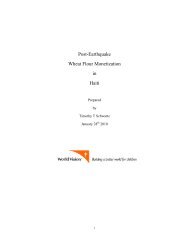CNSA Targeting
You also want an ePaper? Increase the reach of your titles
YUMPU automatically turns print PDFs into web optimized ePapers that Google loves.
17<br />
Beneficiary Criteria Overview<br />
Beneficiary Criteria refers specifically to who is meant to benefit from an aid. With regard to aid<br />
to the vulnerable, we can identify four types of beneficiaries (Lavalee et al 2010):<br />
1) those who have little hope of overcoming their status because of disability or age,<br />
2) those who are discriminated against because of some culturally defined status such as<br />
gender, ethnicity, age, religion, caste or occupation<br />
3) the transient poor who have fallen on hard times because of a crisis in their own lives or<br />
the lives of a member of their family, such as in the case of illness or debt<br />
4) disaster victims who have been hit by a widespread shock such as hurricane, earthquake,<br />
war, or economic recession<br />
The status of category 4, above, that of disaster victims, tends to be aggravated by inclusion in the<br />
former categories. Specifically, in the event of a regional calamity those who tend to suffer first<br />
and most are individuals physically weak because of disability or age, those who suffer a culturally<br />
defined status that makes them vulnerable (such as an ethnic group or stigmatized class), and those<br />
who are already suffering a temporary personal or household economic crisis. On the other hand,<br />
a catastrophic shock may temporarily expose relatively well-off individuals and families to<br />
extreme hardship, inducing the need for immediate relief in the form of medical, nutritional or<br />
financial assistance.<br />
It is important to emphasize again that target beneficiaries may be other than the poor or those in<br />
need of emergency relief. Projects that focus on production may deliberately exclude those who<br />
the most vulnerable—such as the landless or the physically or mentally incapacitated, i.e. people<br />
incapable or unlikely to assist in augmenting production. Projects with the goal of increasing<br />
regional production may focus on the relatively wealthy landowners. Other relatively wealthy<br />
beneficiary targets might be businesses and banks, or scholarships to individuals living in<br />
impoverished regions but who may not be impoverished themselves. Thus, we can add a fifth<br />
category to beneficiary criteria:<br />
5) Individuals, households, or institutions with capacity to increase production, thereby<br />
elevating local living standards through increased employment, availability of goods and<br />
services, or preservation of natural resources<br />
Community Buy-in and Validity<br />
An important dimension of criteria is whose criteria is it? Is the donor or implementing<br />
organization selecting the criteria? Or is the community somehow determining the criteria? Whose<br />
criteria is being used, how well it fits with community reality and values and whether or not the<br />
community members accept the criteria as justifiable have a great deal to do with winning<br />
community buy-in and avoiding conflict and resentment regarding the intervention. But buy-in<br />
must be balanced with validity of the criteria. There are many instances where community<br />
members do not share the objectives of the donors; where community consensus is that those who<br />
most deserve aid are not the neediest but the hardest workers, the entrepreneurially inclined, or<br />
even traditional elites. In cases such as these the values and goals of aid entities must somehow be<br />
reconciled with those of the community or, at the very least, community members must be<br />
convinced of the value of the intervention (see Himmelstine 2012).
















